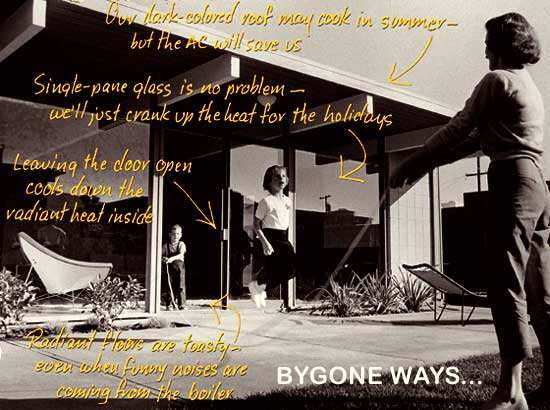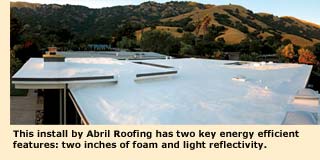Energy Efficiency: Modern Dream, Green Machine

There are certain rules that parents hammered into our heads as children: turn off the lights when you're not using them; shut off the faucet while you're brushing your teeth; close the windows before turning on the air conditioning, and so on. This litany might have been a bit of a drag early on, but once you moved into your own place—with your own bills—'the rules' suddenly began making sense.
Despite our best efforts to maintain cost-efficient and eco-conscious households, living in mid-century modern homes today can pose a few challenges. From searing heat to creeping cold, maintaining a constant temperature in these architectural treasures can become a tiresome chore. Designed during the golden and inexpensive years of energy, many of these homes have a reputation for being energy hogs.
Between 1952 and 1972, the span of years within which most of our homes were built, total energy usage in the U.S. doubled, and electrical energy consumption even tripled. Single-pane glass windows let in the hot summer sun, and inefficient roofing systems let out the warm air in the winter. Traditional plumbing also doesn't stand up to today's water conservation standards. What's a mid-century style homeowner to do today, faced with ever-rising energy bills and cities' every-depleting water supplies?
Thankfully, most of our readers are also progressive. Just as one might soup up a classic vintage car with a faster engine, scratch-resistant paint, and 60,000-mile tires, our homeowners are improving their original homes with better insulation, power-conscious systems, and energy-saving appliances. The term 'eco-friendly' has turned into quite the buzzword, making such improvements a cool thing to do—not only for the environment, but also for our pocketbooks.
Here's a handy checklist of things you can do to boost the energy efficiency in your home—and in the process save on energy bills and live more comfortably.
1. Let's begin at the rooftop

Foam roof insulation. Heat rises and looks to the roof as its first avenue of escape, making roof insulation a logical starting point for energy conservation. Homeowners who have transitioned their original Eichler roof, with its meager half-inch of fiberglass insulation, to a modern insulated roof are oftentimes amazed at how much the new roof helps keep out the heat in the summer and retains a mild temperature inside during the winter. Two inches of rigid foam or spray-on polyurethane foam provide sufficient roof insulation (R-19 value) to make an impact on energy consumption and costs.
"Eichler homes creak and groan as they expand with the heat and the cold," says Randy Feriante, owner of Dura-Foam Roofing in Menlo Park. "With a foam roof, the structure is always the inside temperature." They are also renewable and can be recoated over the years as necessary.
Spray-on foam roofs are also highly reflective, as are other white and light-colored roofing systems, such as single-plies Duro-Last and Johns Manville. In the summer, all of them are effective in reducing heat gain, as well as the need for air conditioning, inside the home.
2. Warming up the 'cold zones'
Wall insulation. If your walls feel cold to the touch in the winter, your home could probably benefit with some additional insulation in the walls. Wall insulation, especially when applied to those walls facing the exterior of your home, will reduce 'cold zones' inside rooms, mostly near walls and windows, and add additional comfort and prevention against heat energy loss. It's worth the effort: retrofitting insulation into existing walls can save you 20 percent on heating bills.
Today, standard fiberglass insulation offers approximately an R-13 value. It's a relatively easy feat to add insulation to walls when replacing exterior siding. If your walls are going to remain shut, however, consider 'blown' insulation. For Eichlers, flexible, four-inch thick fiberglass batts, an inexpensive and easy-to-install insulator, are preferred for inside installations. Wood paneling or sheet rock can be reinstalled over the insulation afterwards.




